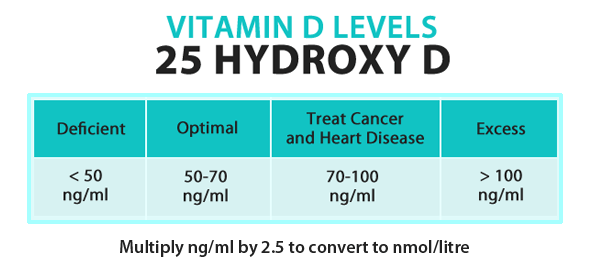By: Dr. Mercola
Source: Mercola.com
Nearly half of people with epilepsy are also vitamin D deficient, but despite this well-known association, only a single study has been published on the effect of vitamin D for seizure control in the last 40 years.
That study revealed that treating epileptic patients with vitamin D2 – the far inferior type of synthetic vitamin D – reduced the number of seizures, and in 1974 researchers concluded that “the results may support the concept that epileptics should be treated prophylactically with vitamin D.“
Now, nearly four decades later researchers have again revealed that “the normalization of serum vitamin 25(OH)D
Improving Vitamin D Levels Reduces Seizures by 40%
In the latest study, researchers administered a one-time 40,000-200,000 IU dose of vitamin D3 to patients with epilepsy in order to bring their vitamin D levels out of a deficiency state.
The participants, who ranged in age from 10-42, had vitamin D levels ranging from 4 ng/ml to 34 ng/ml, with a median level of 11.8. This is an absolutely dangerously low level. As you can see in the chart below, anything below 50 ng/ml is a deficiency state.

After the treatment dose of vitamin D, the participants’ vitamin D levels did improve to a range of 23-45 ng/ml, with a median of 38 ng/ml. It’s important to note that this is still low according to the latest science … but the improvement still resulted in a decrease in their number of seizures. If their levels were optimized further, it’s likely the results would improve even more.
After increasing their vitamin D levels, the results showed:
- 10 of the 13 subjects had a decrease in number of seizures
- Overall, there was a median seizure number reduction of 40%
- A seizure reduction of greater than 50% was experienced in five patients
The most revealing result, however, occurred among the person whose vitamin D was a dangerously low 4 ng/ml at the start of the study. This person had 450 seizures in a three-month period, but after raising vitamin D level to 43.1 ng/ml, the seizures dropped to 30 in three months! The study did have some limitations, namely the small number of subjects and the lack of a placebo to compare to, but it still highlighted the importance of correcting vitamin D deficiency in epilepsy patients.
Epilepsy Patients are at Increased Risk of Vitamin D Deficiency
The findings are even more important given that people with epilepsy face an even greater risk of vitamin D deficiency than the general population (and even the general population is vastly vitamin D deficient). The reasons are two-fold, with the first being that having frequent seizures may interfere with your ability to get outdoors and stay active.
If you spend most of your time inside, you’ll miss out on regular sun exposure, which is key for the natural production of vitamin D. Even exposing your skin to sunlight through a windowpane will prevent the entry of the UVB rays, which are the specific wavelength that produces vitamin D in your skin. So, it is crucial that you get outside and experience direct skin contact with the sunlight instead of sunning in a sunroom, for instance.
Second, anti-epileptic drugs that are often given to epilepsy patients can interfere with vitamin D metabolism, leading to deficiency. If you take these drugs, it is especially crucial that you actively monitor your vitamin D levels to avoid this side effect.
Why might vitamin D have such a significant impact on epileptic seizures? Epilepsy is a disorder of the central nervous system, particularly your brain. Vitamin D is not “just” a vitamin; it’s actually a neuroregulatory steroidal hormone that influences nearly 3,000 different genes in your body. Vitamin D receptors can be found in your brain, spinal cord, and central nervous system, and may enhance the amount of important chemicals in your brain needed to protect brain cells, for starters.
The Study Used Supplements, But Sunshine is Better
Researchers used a one-time large dose of vitamin D3 to boost the participants’ vitamin D levels. If you’re going to supplement, vitamin D3 is certainly far superior to the vitamin D2 researchers used back in the 1970s.
Today, however, vitamin D2 is still the form typically prescribed by doctors, so be aware of this if you’re taking this nutrient in prescription form. A meta-analysis of 50 clinical trials looking at mortality rates for “doctor recommended” synthetic vitamin D2 supplements versus natural vitamin D3 shows a 6 percent risk reduction among those who used D3, compared to a 2 percent increased risk among those who used D2.
Research also shows vitamin D3 is approximately 87 percent more potent in raising and maintaining vitamin D concentrations and produces 2- to 3-fold greater storage of vitamin D than does D2. D3 is also converted into its active form 500 percent faster. So by all means use vitamin D3 if you’re going to supplement, not D2 – but even better, simply get out in the sun, or use a safe tanning bed.
The IDEAL way to optimize your vitamin D levels is through appropriate sun or safe tanning bed exposure. While your skin does create vitamin D3 in response to sunlight, which is theoretically the same as the D3 you get from an oral supplement, there’s cause to believe that the vitamin D created from sun exposure may have additional health benefits. Plus, you cannot overdose when getting your vitamin D from sun exposure, as your body has the ability to self-regulate and only make what it needs. You do, however, need to be cautious and avoid burning.
If you cannot get your vitamin D requirements from sun exposure, I recommend using a safe tanning bed (one with electronic ballasts rather than magnetic ballasts, to avoid unnecessary exposure to EMF fields). Safe tanning beds also have less of the dangerous UVA than sunlight, while unsafe ones have more UVA than sunlight. If neither of these are feasible options, then you should take an oral vitamin D3 supplement. It will certainly be better than no vitamin D at all, but you will need to monitor your levels via blood testing to ensure you stay within the therapeutic range.
You can learn more about maximizing your vitamin D from safe sun exposure in the video below. If you have epilepsy, it’s possible that doing so could help you decrease seizure drugs (a very good thing, since all seizure drugs can increase your risk of suicidal thoughts and behaviors, and some of these drugs can make you lose your memory and your hair).
To view the original article click here.
To reprint this article, visit the source website for reprinting guidelines






